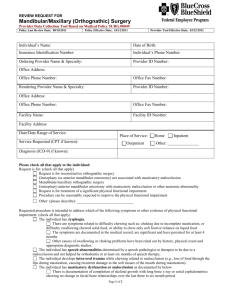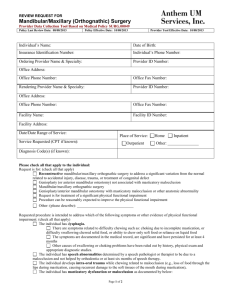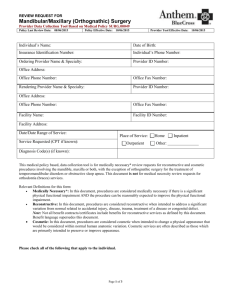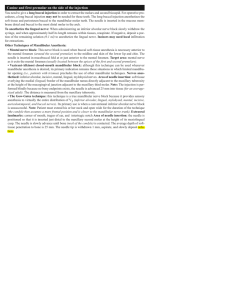Alveolar and dental arch morphology in Angle Class II division 2
advertisement
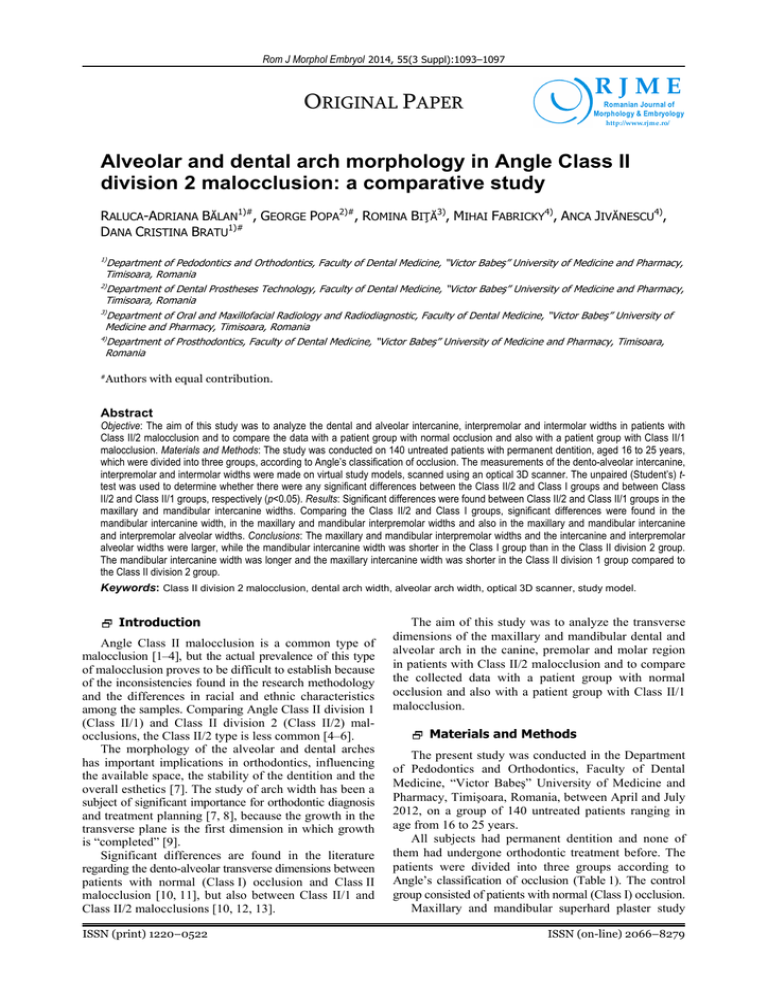
Rom J Morphol Embryol 2014, 55(3 Suppl):1093–1097 RJME ORIGINAL PAPER Romanian Journal of Morphology & Embryology http://www.rjme.ro/ Alveolar and dental arch morphology in Angle Class II division 2 malocclusion: a comparative study RALUCA-ADRIANA BĂLAN1)#, GEORGE POPA2)#, ROMINA BIŢĂ3), MIHAI FABRICKY4), ANCA JIVĂNESCU4), DANA CRISTINA BRATU1)# 1) Department of Pedodontics and Orthodontics, Faculty of Dental Medicine, “Victor Babeş” University of Medicine and Pharmacy, Timisoara, Romania 2) Department of Dental Prostheses Technology, Faculty of Dental Medicine, “Victor Babeş” University of Medicine and Pharmacy, Timisoara, Romania 3) Department of Oral and Maxillofacial Radiology and Radiodiagnostic, Faculty of Dental Medicine, “Victor Babeş” University of Medicine and Pharmacy, Timisoara, Romania 4) Department of Prosthodontics, Faculty of Dental Medicine, “Victor Babeş” University of Medicine and Pharmacy, Timisoara, Romania #Authors with equal contribution. Abstract Objective: The aim of this study was to analyze the dental and alveolar intercanine, interpremolar and intermolar widths in patients with Class II/2 malocclusion and to compare the data with a patient group with normal occlusion and also with a patient group with Class II/1 malocclusion. Materials and Methods: The study was conducted on 140 untreated patients with permanent dentition, aged 16 to 25 years, which were divided into three groups, according to Angle’s classification of occlusion. The measurements of the dento-alveolar intercanine, interpremolar and intermolar widths were made on virtual study models, scanned using an optical 3D scanner. The unpaired (Student’s) ttest was used to determine whether there were any significant differences between the Class II/2 and Class I groups and between Class II/2 and Class II/1 groups, respectively (p<0.05). Results: Significant differences were found between Class II/2 and Class II/1 groups in the maxillary and mandibular intercanine widths. Comparing the Class II/2 and Class I groups, significant differences were found in the mandibular intercanine width, in the maxillary and mandibular interpremolar widths and also in the maxillary and mandibular intercanine and interpremolar alveolar widths. Conclusions: The maxillary and mandibular interpremolar widths and the intercanine and interpremolar alveolar widths were larger, while the mandibular intercanine width was shorter in the Class I group than in the Class II division 2 group. The mandibular intercanine width was longer and the maxillary intercanine width was shorter in the Class II division 1 group compared to the Class II division 2 group. Keywords: Class II division 2 malocclusion, dental arch width, alveolar arch width, optical 3D scanner, study model. Introduction Angle Class II malocclusion is a common type of malocclusion [1–4], but the actual prevalence of this type of malocclusion proves to be difficult to establish because of the inconsistencies found in the research methodology and the differences in racial and ethnic characteristics among the samples. Comparing Angle Class II division 1 (Class II/1) and Class II division 2 (Class II/2) malocclusions, the Class II/2 type is less common [4–6]. The morphology of the alveolar and dental arches has important implications in orthodontics, influencing the available space, the stability of the dentition and the overall esthetics [7]. The study of arch width has been a subject of significant importance for orthodontic diagnosis and treatment planning [7, 8], because the growth in the transverse plane is the first dimension in which growth is “completed” [9]. Significant differences are found in the literature regarding the dento-alveolar transverse dimensions between patients with normal (Class I) occlusion and Class II malocclusion [10, 11], but also between Class II/1 and Class II/2 malocclusions [10, 12, 13]. ISSN (print) 1220–0522 The aim of this study was to analyze the transverse dimensions of the maxillary and mandibular dental and alveolar arch in the canine, premolar and molar region in patients with Class II/2 malocclusion and to compare the collected data with a patient group with normal occlusion and also with a patient group with Class II/1 malocclusion. Materials and Methods The present study was conducted in the Department of Pedodontics and Orthodontics, Faculty of Dental Medicine, “Victor Babeş” University of Medicine and Pharmacy, Timişoara, Romania, between April and July 2012, on a group of 140 untreated patients ranging in age from 16 to 25 years. All subjects had permanent dentition and none of them had undergone orthodontic treatment before. The patients were divided into three groups according to Angle’s classification of occlusion (Table 1). The control group consisted of patients with normal (Class I) occlusion. Maxillary and mandibular superhard plaster study ISSN (on-line) 2066–8279 Raluca-Adriana Bălan et al. 1094 models were obtained from all of the patients (Figures 1 and 2). Table 1 – Descriptive statistics of the analyzed cases Average Gender Angle’s No. of age classification Percentage cases ± SD of occlusion Males Females [years] Class I occlusion Class II/1 malocclusion Class II/2 malocclusion 48 27 21 21±2.15 34.3% 40 15 25 18±2.15 28.6% 52 20 32 19±2.15 37.1% SD: Standard deviation. The study models were scanned using the optical 3D scanner Activity 101 (Smart Optics Sensortechnik, Germany) (Figure 3). All the consecutive measurements were done on the resulting virtual study models, using the open-source software MeshLab 1.3.2. We analyzed several dentoalveolar parameters (Figures 4 and 5). The intercanine width was calculated as the distance between the cusp tips (or the center of the wear facets due to attrition) of the right and left maxillary permanent canines (Max C-C) and mandibular permanent canines (Mand C-C), respectively. The interpremolar width was calculated as the distance between the buccal cusp tips (or the center of the wear facets due to attrition) of the right and left maxillary first premolars (Max P-P) and mandibular first premolars (Mand P-P), respectively. The intermolar width was calculated as the distance between the mesiobuccal cusp tips (or the center of the wear facets due to attrition) of the right and left maxillary permanent first molars (Max M-M) and mandibular permanent first molars (Mand M-M), respectively. The intercanine alveolar width was calculated as the distance between the most lateral points situated at the mucogingival junction, above the cusp tips of the right and left maxillary canines (Max C-C alveolar) and below the cusp tips of the right and left mandibular canines (Mand C-C alveolar). The interpremolar alveolar width was calculated as the distance between the most lateral points situated at the mucogingival junction, above the interproximal contact points of the maxillary first and second premolars, on each side (Max P-P alveolar) and below the interproximal contact points of the mandibular first and second premolars, on each side (Mand P-P alveolar). The intermolar alveolar width was calculated as the distance between the most lateral points situated at the mucogingival junction, above the mesiobuccal cusp tips of the right and left maxillary permanent first molars (Max M-M alveolar) and below the mesiobuccal cusp tips of the right and left mandibular permanent first molars (Mand M-M alveolar). Figure 1 – Angle Class II/2 maxillary Figure 2 – Angle Class II/2 mandibular Figure 3 – Optical 3D scanner Activity superhard plaster study model. superhard plaster study model. 101 (Smart Optics Sensortechnik, Germany). Figure 4 – The measurement of intermolar, interpremolar and intercanine width on a Class II/2 maxillary virtual study model. One week after the first measurements were taken, 20 study models were randomly selected and remeasured. The statistical analyses and the interpretation of the results were carried out in the Department of Biostatistics and Medical Informatics, “Victor Babeş” University of Medicine and Pharmacy, Timişoara. Specialized software was used to analyze the data (SPSS 17, OpenEpi 2.3.1). Figure 5 – The measurement of intermolar, interpremolar and intercanine width on a Class II/2 mandibular virtual study model. The unpaired Student’s t-test was used to determine whether there were any significant differences between the means of the parameters measured in the Class II/2 and Class II/1 study models and also in the Class II/2 and Class I study models. The level of statistical significance was assessed as follows: p>0.05 – no statistically significant differences; Alveolar and dental arch morphology in Angle Class II division 2 malocclusion: a comparative study p<0.05 – statistically significant differences; p<0.01 – highly statistically significant differences; p<0.001 – very highly statistically significant differences. Table 2 – Error of the method and reliability coefficient Measured width [mm] Max C-C Mand C-C Max P-P Mand P-P Max M-M Mand M-M Max C-C alveolar Mand C-C alveolar Max P-P alveolar Mand P-P alveolar Max M-M alveolar Mand M-M alveolar Results A paired-samples Student’s t-test showed no significant differences between the first and the second set of measurements taken on the 20 study models. The method error was calculated using Dahlberg’s formula. The values varied from 0.392 to 0.934 and were within acceptable limits (Table 2). The highest value for the reliability coefficient (r=0.984) was recorded for the maxillary intercanine width, while the lowest value (r=0.923) was recorded for the mandibular intermolar alveolar width measurements. The mean values of the measured parameters in the study models and the statistical evaluation of the data are presented in Tables 3 and 4. 1095 Dahlberg’s error analysis 0.934 0.877 0.490 0.725 0.437 0.621 0.401 0.604 0.452 0.432 0.397 0.392 Reliability coefficient 0.984 0.977 0.980 0.985 0.937 0.931 0.941 0.947 0.932 0.939 0.957 0.923 Max: Maxillary; Mand: Mandible; C-C: Intercanine; P-P: Interpremolar; M-M: Intermolar. Table 3 – Statistical evaluation of the measured parameters in the Class II/2 and Class II/1 study models Measured width [mm] Mean ± SD Class II/2 Minimum Maximum Mean ± SD Class II/1 Minimum Maximum p Student’s t-test Max C-C Mand C-C Max P-P Mand P-P Max M-M Mand M-M Max C-C alveolar Mand C-C alveolar Max P-P alveolar Mand P-P alveolar Max M-M alveolar Mand M-M alveolar 35.1±2.6 26.6±1.8 39.6±2.7 34.5±2.4 50.9±2.8 46.6±2.7 37.6±2.3 34.3±2.7 44.8±2.6 40.5±2.4 57.1±2.8 56.9±3.1 30.2 22.5 32.5 29.0 42.8 29.4 32.3 22.9 32.4 28.7 49.8 37.9 41.1 32.2 49.3 40.5 57.4 53.2 44.6 32.3 53.2 47.1 65.1 63.1 33.9±2.6 27.9±1.9 39.9±2.7 34.7±2.3 51.9±2.7 46.2±3.1 36.9±2.3 34.5±2.7 44.9±2.6 40.7±2.3 56.4±3.0 55.9±3.5 29.4 23.7 32.7 29.6 37.7 35.7 32.5 22.9 40.8 28.9 50.2 33.1 43.0 32.5 49.2 39.7 57.4 55.4 44.6 32.3 53.0 46.5 65.4 63.9 0.030* 0.001** 0.051 0.686 0.086 0.518 0.151 0.725 0.855 0.686 0.256 0.157 *Statistically significant differences (p<0.05); **Highly statistically significant differences (p<0.01); SD: Standard deviation; refer to Table 2 footnotes for additional information. Table 4 – Statistical evaluation of the measured parameters in the Class II/2 and Class I study models Measured width [mm] Mean ± SD Class II/2 Minimum Maximum Mean ± SD Class I Minimum Maximum p Student’s t-test Max C-C Mand C-C Max P-P Mand P-P Max M-M Mand M-M Max C-C alveolar Mand C-C alveolar Max P-P alveolar Mand P-P alveolar Max M-M alveolar Mand M-M alveolar 35.1±2.6 26.6±1.8 39.6±2.7 34.5±2.4 50.9±2.8 46.6±2.7 37.6±2.3 34.3±2.7 44.8±2.6 40.5±2.4 57.1±2.8 56.9±3.1 30.2 22.5 32.5 29.0 42.8 29.4 32.3 22.9 32.4 28.7 49.8 37.9 41.1 32.2 49.3 40.5 57.4 53.2 44.6 32.3 53.2 47.1 65.1 63.1 34.4±2.1 25.9±1.7 42.2±2.7 35.4±1.9 50.8±3.7 45.9±2.8 38.9±2.3 35.7±2.1 49.2±2.6 48.6±2.7 57.9±5.1 57.3±2.9 27.4 21.7 33.6 31.2 44.8 38.1 33.2 29.7 41.9 40.8 56.2 50.1 40.1 32.9 52.4 39.1 59.1 51.6 45.1 41.1 57.0 54.2 65.2 64.1 0.140 0.048* <0.001*** 0.039* 0.880 0.206 0.005** 0.004** <0.001*** <0.001*** 0.339 0.506 *Statistically significant differences (p<0.05); **Highly statistically significant differences (p<0.01); ***Very highly statistically significant differences (p<0.001); SD: Standard deviation; refer to Table 2 footnotes for additional information. Comparing the mean values between the Class II/2 group and the Class II/1 group, the Student’s t-test showed statistically significant differences in the maxillary intercanine width (p<0.05) and highly statistically significant differences in the mandibular intercanine width (p<0.01). The mandibular intercanine width was larger in the Class II division 1 group and shorter in the normal occlusion group, compared to the subjects with Class II division 2 malocclusion. Comparing the mean values between the Class II/2 group and the control (Class I) group, we found statistically significant differences in the mandibular intercanine and interpremolar widths (p<0.05) and very highly statistically significant differences in the maxillary interpremolar width (p<0.001). When referring to the alveolar widths, we found highly statistically significant differences in the maxillary and mandibular 1096 Raluca-Adriana Bălan et al. intercanine alveolar widths (p<0.01) and very highly statistically significant differences in the maxillary and mandibular interpremolar alveolar widths (p<0.001). The maxillary and mandibular intercanine and interpremolar alveolar widths were larger in the Class I group than in the Class II division 2 group. The Class II division 2 and Class I groups had similar maxillary intercanine widths, but larger widths than the Class II division 1 group. The Class II division 2 and Class II division 1 groups had similar maxillary and mandibular interpremolar widths, but shorter widths than the Class I group. No significant differences were found between the studied groups in the dento-alveolar intermolar maxillary and mandibular widths. Discussion Several authors have previously studied the growth of the dental arch in patients with normal occlusion and compared the results with patients with malocclusions. There are many controversies regarding the results presented in the literature. The majority of these studies analyzed a limited number of clinical cases; therefore, the validity of these results is questioned. Collecting data on Class II/2 clinical cases has always proved challenging because of the low prevalence rates, therefore scarce data was found in the literature related to the transverse dimensions in this type of malocclusion. Enlow and Hans [14] addressed the dental and skeletal features and the facial growth of Class II malocclusion without differentiating Class II division 1 from Class II division 2 and concluded that Class II patients have long, narrow palates and maxillary arches. Numerous studies advocate that the deep bite in Class II malocclusion may also cause a deficit in the growth of the mandibular dento-alveolar segment in the sagittal plane [6, 14–16]. In a study, with larger samples than the ones used in our research, Uysal et al. [5] compared the transverse dimensions of the dento-alveolar arches in the canine, premolar and molar regions of Class II/1 and Class II/2 malocclusion groups with a control group of adult subjects with normal occlusion. All the mandibular alveolar widths, the maxillary interpremolar width and the maxillary intercanine and interpremolar alveolar widths were significantly shorter in the Class II/2 group than in the normal occlusion control group. The maxillary intermolar width was larger and the mandibular intercanine and interpremolar widths were shorter in subjects with Class II/2 malocclusion, when compared with the Class II/1 subjects. Our research corroborates most of these results, although we did not find any significant differences between the studied groups in the dento-alveolar intermolar maxillary and mandibular widths, possibly due to the smaller sample size. The results in our study showed that the mandibular intercanine width was larger in Class II/2 malocclusion compared to Class I normal occlusion. Qamar et al. [17] found similar results, but concluded that the intermolar width was also larger in the Class II/2 group than in the subjects with normal occlusion. Walkow and Peck [6] contradict our findings, showing that the mandibular intercanine width was significantly shorter in Class II/2 deep-bite patients than in age and gender matched patients with normal occlusion and suggested that the excessive deep bite may inhibit the development of the anterior dento-alveolar mandibular region. In a cross-sectional study of 386 white women, Buschang et al. [10] found that Class II division 2 patients had wider maxillary intercanine widths compared to Class II division 1 patients. However, the Class II division 2 patients had narrower mandibular intercanine and intermolar widths than the Class II division 1 and Class I patients. Regarding the maxillary intermolar width, Buschang et al. [10] and Huth et al. [18] reported smaller values in the Class II/1 group and larger values in the Class I group than in the Class II/2 subjects. Huth et al. [18] also found in their study that the Class II/2 group had maxillary intercanine widths and intermolar alveolar widths significantly shorter than the patients with normal occlusions and significantly larger than the Class II/1 group. Their results showed that all groups had similar mandibular intercanine widths and intermolar alveolar widths with no significant differences between the groups. The Class II/2 and Class II/1 groups had similar mandibular intermolar widths, but both groups had shorter widths compared to the normal occlusion group. Moorrees et al. [19] compared the arch dimensions of untreated Class II division 1 and division 2 patients using dental study models and concluded that the control (Class I) group had narrower the maxillary and mandibular intercanine widths than the Class II division 2, whereas the maxillary and mandibular intermolar widths were within normal limits. Our study showed similar results, with the exception of the maxillary intercanine distance, where we did not find any significant difference between the Class II/2 and Class I subjects. Contrary to our findings, several studies [20–22] found no significant dental and skeletal differences between Class II division 1 and division 2 malocclusions. The absence of any definite differences could be the result of several factors such as different inclusion and exclusion criteria, lack of homogeneity in the age groups and reduced sample size. Lux et al. [12] found that the dental arch widths of Class II/2 subjects had values in the range between the Class II/1 cases and the Class I control group. Our results and most of the above-mentioned studies are in agreement with these findings. Conclusions The maxillary and mandibular interpremolar widths were larger in the Class I group compared to the Class II division 2 group, while the mandibular intercanine width was shorter. The intercanine and interpremolar alveolar widths were also larger in the Class I group compared to the Class II division 2 subjects. The mandibular intercanine width was longer and the maxillary intercanine width was shorter in the Class II division 1 group compared to the Class II division 2 group. No significant differences were found between the studied groups in the dentoalveolar intermolar maxillary and mandibular widths. Alveolar and dental arch morphology in Angle Class II division 2 malocclusion: a comparative study References [1] Burgersdijk R, Truin GJ, Frankenmolen F, Kalsbeek H, van’t Hof M, Mulder J, Malocclusion and orthodontic treatment need of 15–74-year-old Dutch adults, Community Dent Oral Epidemiol, 1991, 19(2):64–67. [2] Willems G, De Bruyne I, Verdonck A, Fieuws S, Carels C, Prevalence of dentofacial characteristics in a Belgian orthodontic population, Clin Oral Investig, 2001, 5(4):220–226. [3] Silva RG, Kang DS, Prevalence of malocclusion among Latino adolescents, Am J Orthod Dentofacial Orthop, 2001, 119(3): 313–315. [4] Gelgör IE, Karaman AI, Ercan E, Prevalence of malocclusion among adolescents in Central Anatolia, Eur J Dent, 2007, 1(3):125–131. [5] Uysal T, Memili B, Usumez S, Sari Z, Dental and alveolar arch widths in normal occlusion, class II division 1 and class II division 2, Angle Orthod, 2005, 75(6):941–947. [6] Walkow TM, Peck S, Dental arch width in Class II Division 2 deep-bite malocclusion, Am J Orthod Dentofacial Orthop, 2002, 122(6):608–613. [7] Lee RT, Arch width and form: a review, Am J Orthod Dentofacial Orthop, 1999, 115(3):305–313. [8] Bratu DC, Bratu EA, Popa G, Luca M, Bălan R, Ogodescu A, Skeletal and dentoalveolar changes in the maxillary bone morphology using two-arm maxillary expander, Rom J Morphol Embryol, 2012, 53(1):35–40. [9] Proffit WR, Fields HW Jr., Sarver DM, Contemporary orthoth dontics, 4 edition, Mosby–Elsevier, St. Louis, 2007, 113. [10] Buschang PH, Stroud J, Alexander RG, Differences in dental arch morphology among adult females with untreated Class I and Class II malocclusion, Eur J Orthod, 1994, 16(1):47–52. [11] Slaj M, Spalj S, Pavlin D, Illes D, Slaj M, Dental archforms in dentoalveolar Class I, II and III, Angle Orthod, 2010, 80(5): 919–924. [12] Lux CJ, Conradt C, Burden D, Komposch G, Dental arch widths and mandibular-maxillary base widths in Class II malocclusions between early mixed and permanent dentitions, Angle Orthod, 2003, 73(6):674–685. 1097 [13] Staley RN, Stuntz WR, Peterson LC, A comparison of arch widths in adults with normal occlusion and adults with Class II, division 1 malocclusion, Am J Orthod, 1985, 88(2):163–169. st [14] Enlow DH, Hans MG, Essentials of facial growth, 1 edition, W.B. Saunders, Philadelphia, 1996, 1–280. [15] McNamara JA Jr., Early intervention in the transverse dimension: is it worth the effort? Am J Orthod Dentofacial Orthop, 2002, 121(6):572–574. [16] Bishara SE, Jakobsen JR, Treder J, Nowak A, Arch width changes from 6 weeks to 45 years of age, Am J Orthod Dentofacial Orthop, 1997, 111(4):401–409. [17] Qamar R, Yousaf U, Riaz M, Dental arch widths in Class I normal occlusion and Class II division 2 malocclusion, Pakistan Oral & Dental Journal, 2012, 32(3):427–429. [18] Huth J, Staley RN, Jacobs R, Bigelow H, Jakobsen J, Arch widths in Class II-2 adults compared to adults with Class II-1 and normal occlusion, Angle Orthod, 2007, 77(5):837–844. [19] Moorrees CF, Gron AM, Lebret LM, Yen PK, Fröhlich FJ, Growth studies of the dentition: a review, Am J Orthod, 1969, 55(6):600–616. [20] Pancherz H, Zieber K, Hoyer B, Cephalometric characteristics of Class II division 1 and Class II division 2 malocclusions: a comparative study in children, Angle Orthod, 1997, 67(2): 111–120. [21] Zentner A, Peylo S, Brothag D, Predictive value of morphologic parameters for successful correction of Class II division 2 malocclusion, Am J Orthod Dentofacial Orthop, 2003, 123(3): 279–285. [22] Riesmeijer AM, Prahl-Andersen B, Mascarenhas AK, Joo BH, Vig KW, A comparison of craniofacial Class I and Class II growth patterns, Am J Orthod Dentofacial Orthop, 2004, 125(4):463–471. Corresponding authors Dana Cristina Bratu, Assistant Professor, DMD, PhD, Department of Pedodontics and Orthodontics, Faculty of Dental Medicine, “Victor Babeş” University of Medicine and Pharmacy, 9 Revoluţiei 1989 Avenue, 300041 Timişoara, Romania; Phone +40744–835 314, e-mail: danacristinabratu@yahoo.com George Popa, DMD, PhD Student, Department of Dental Prostheses Technology, Faculty of Dental Medicine, “Victor Babeş” University of Medicine and Pharmacy, 9 Revoluţiei 1989 Avenue, 300041 Timişoara, Romania; Phone +40741–031 456, e-mail: georgepopa86@yahoo.com Received: May 27, 2014 Accepted: November 4, 2014
